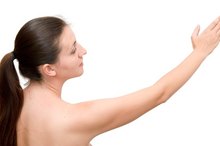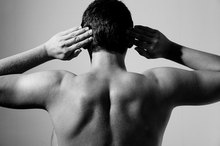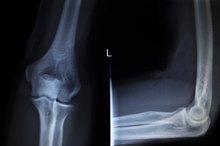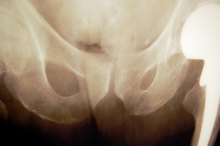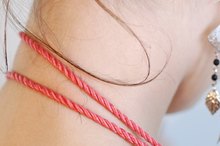What Are the Causes of Pain in the Back of the Arm?
Many conditions and injuries can cause pain in the back of the arm. According to Seattle Children's Hospital, a 250-bed children's hospital in Seattle, Washington, arm pain, including pain in the back of the arm, can be caused by trauma, overuse injuries and certain medical conditions. Pain in the back of the arm ranges from mild to severe. In some cases, pain in the back of the arm can limit a person's activities of daily living.
Muscle Bruise
A muscle bruise, also known as a contusion, can cause pain in the back of the arm. According to the American Academy of Orthopaedic Surgeons, or AAOS, muscle bruises are common sports-related injuries. Muscle bruises in the back of the arm occur when that segment of the body sustains a direct blow or blunt-force trauma, which crushes underlying muscle fibers and connective tissue, but does not break the skin or cause a laceration. Common signs and symptoms associated with a muscle bruise include pain at the injury site; decreased range of motion in nearby joints; and an observable swelling or lump called a hematoma, which is an accumulation of blood from broken blood vessels. Because muscle bruises are usually caused by blunt-force trauma, other co-existing injuries may also be present, such as fractures, dislocations, torn muscles or injured ligaments.
- A muscle bruise, also known as a contusion, can cause pain in the back of the arm.
- Common signs and symptoms associated with a muscle bruise include pain at the injury site; decreased range of motion in nearby joints; and an observable swelling or lump called a hematoma, which is an accumulation of blood from broken blood vessels.
Triceps Muscle Strain
Causes of Pain on the Right Side Under the Arm
Learn More
A triceps muscle strain can cause pain in the back of the arm. The Sports Injury Clinic website states that triceps muscle strains—and even complete ruptures of the triceps tendon—sometimes occur among weightlifters and other athletes. The triceps muscle is the large muscle on the posterior aspect, or back side, of the upper arm. The triceps muscle is responsible for stabilizing the elbow and shoulder joints and assisting their movements. A triceps muscle strain—a stretching or tearing of the muscles fibers that compose the triceps muscle—usually occurs at the weakest part of the triceps muscle unit, which may be the junction between one of the muscle bellies and the tendinous portion of the triceps. Common signs and symptoms associated with a triceps muscle strain include pain in the back of the arm, muscle spasm in the affected area, and reduced strength and active range of motion on the involved side.
- A triceps muscle strain can cause pain in the back of the arm.
- A triceps muscle strain—a stretching or tearing of the muscles fibers that compose the triceps muscle—usually occurs at the weakest part of the triceps muscle unit, which may be the junction between one of the muscle bellies and the tendinous portion of the triceps.
Humerus Fracture
A humerus fracture can cause pain in the back of the arm. According to the Sports Injury Clinic website, one of the most common locations for a humerus, or upper arm, bone fracture is the neck of the humerus. The neck of the humerus is located at the top of the arm bone, near the glenoid, or shoulder, socket. A fracture of the neck of the humerus is often caused by falling onto an outstretched hand or by blunt-force trauma to the shoulder. This type of injury is more common among young adults, teenagers and older individuals. Common signs and symptoms associated with a humerus fracture include pain in the back of the arm and shoulder, swelling and bruising in the affected area, and reduced shoulder and arm active range of motion. The Sports Injury Clinic website states that fractures of the neck of the humerus may occur in conjunction with shoulder dislocations.
- A humerus fracture can cause pain in the back of the arm.
- The Sports Injury Clinic website states that fractures of the neck of the humerus may occur in conjunction with shoulder dislocations.
Related Articles
References
- American Academy of Orthopaedic Surgeons: Muscle Contusion (Bruise)
- Sports Injury Clinic: Inflammation and Rupture of the Triceps Tendon
- Sports Injury Clinic: Fracture of the Neck of the Humerus
- Johns Hopkins University, Johns Hopkins Medicine, "Humerus Fracture (Upper Arm Fracture)"
- Cadet ER, et al. Proximal Humerus and Humeral Shaft NonunionsJ Am Acad Orthop Surg. 2013 Sep;21(9):538-47. DOI:10.5435/JAAOS-21-09-538
- Carroll EA, et al. Management of Humeral Shaft FracturesJ Am Acad Orthop Surg July 2012 vol. 20 no. 7 423-433. DOI: 10.5435/JAAOS-20-07-423 PMID: 22751161
- N10CTÂ View Profile
- ho_124Â View Profile
- mivi320Â View Profile
Writer Bio
Martin Hughes is a chiropractic physician, health writer and the co-owner of a website devoted to natural footgear. He writes about health, fitness, diet and lifestyle. Hughes earned his Bachelor of Science in kinesiology at the University of Waterloo and his doctoral degree from Western States Chiropractic College in Portland, Ore.
